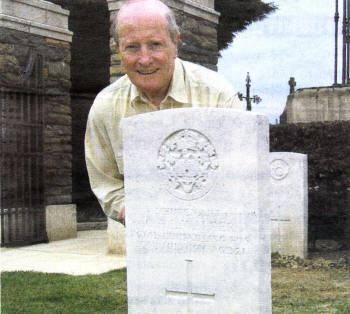|
by Rev Canon Alex Cheevers
 WHEN
I was first appointed Rector of Magheragall in June 1991 I was
interested in those whose names appeared on the War Memorial in
the Church. WHEN
I was first appointed Rector of Magheragall in June 1991 I was
interested in those whose names appeared on the War Memorial in
the Church.
I soon discovered that one of the names was that of the son
of a former Rector of Magheragall, the Rev. Canon Robert Walker,
L.L.D. and Mrs. Walker. The Walkers had come to live at
Magheragall Rectory when Robert was appointed Rector in 1894.
The year after they arrived at Magheragall their son Claude was
born, and was baptised in the Parish Church on March 11, 1895.
Claude grew up at Magheragall Rectory, and then, in 1906, when
he was eleven years of age, Claude's father was appointed Rector
of St. Barnabas' Parish Church in Belfast.
Eight years later the First World War broke out and the young
Claude, now aged nineteen, "joined up". He became part of the
2nd Battalion The Royal Inniskilling Fusiliers. The Army very
quickly saw his potential as an Officer and he was sent off to
the Officer Training College at Sandhurst. He was commissioned
in May 1915 and in due course was posted with his Battalion to
the Somme. And it was at the Somme, on the tenth day of that
famous Battle, that Claude was killed. By that time his father
was Rector of St. Matthew's Parish on the Shankill Road.
A few weeks ago I was able to fulfil a long-held desire to
visit Claude's grave at the Somme. That desire had been with me
since I first discovered the story behind the words on
Magheragall War Memorial - Claude Walker, Lieutenant, 2nd
Battalion Royal Inniskilling Fusiliers.
Lieutenant Claude Walker lies buried in the Commonwealth War
Graves Commission section at the far end of the Communal
Cemetery in Bouzincourt, not far from the town of Albert, at the
heart of the Somme Battlefield. A quiet little cemetery. And
that day as I walked through the Communal Cemetery towards
Claude's grave I overtook an elderly local French-man who had
stopped and was standing crying, cap held respectfully in hand,
at a grave in the local section of the Cemetery.
I waited a few minutes and gave him time for his own
thoughts, then I went over and spoke quietly to the man. I
didn't want to intrude, but I felt sorry for him standing there
all alone, a broken man. The grave with the fresh flowers was
that of his wife who had died a few weeks before, leaving him
alone in the world. He wanted to talk. I shared with him a
chocolate bar I was eating.
And after entering a little bit in to that poor man's grief
and loss, it wasn't difficult a few minutes later to enter a
little bit in to the grief of the Walker family as I knelt at
their son's grave. Canon Walker may have been a former Rector of
Magheragall, and his wife may have been a clergy wife. But they
too would have felt all the grief and pain that so many families
across our land were feeling before that First World War finally
came to an end. All of those families, and those who served and
those who died, deserve to be remembered. If you would like to
make your own pilgrimage to the battlefields of France, Belgium
and Holland I would be delighted if you wanted to join one of
the tours I organize and lead, focusing on the personal stories
behind the headstones. Next year I am planning three tours.
The first is to the area of the Battle of the
Somme, taking in the Ulster Tower, the Thiepval Memorial and
Connaught Cemetery, as well as the original trenches at
Newfoundland Park From there we go on to the D Day landing areas
of Normandy, taking in all of the five landing-beaches, as well
as the Air Landing Areas of the 6th Airborne Division.
The second tour visits the Memorials,
cemeteries and beaches of Dunkirk 1940, the Bridge too Far at
Arnhem from 1944, and also the First World War battlefields of
Messines, Passchendael and Ypres, with an opportunity to attend
the daily Menin Gate Sunset Act of Remembrance. The Third tour
is a new one for 2009, visiting amongst many other unique and
unusual things Hitler's V2 rocket bunker, the camp from which
50,000 were deported to the Death Camps, and many unique and
unusual places associated with the two World Wars in northern
France. This tour also takes in the Battle of the Somme.
These few words don't do justice to any of
the tours. If you would like full details please give me a ring
on 9269 0701 and I will send you a brochure.
Ulster Star
26/12/2008
 |